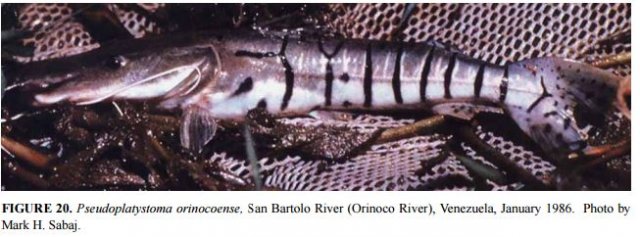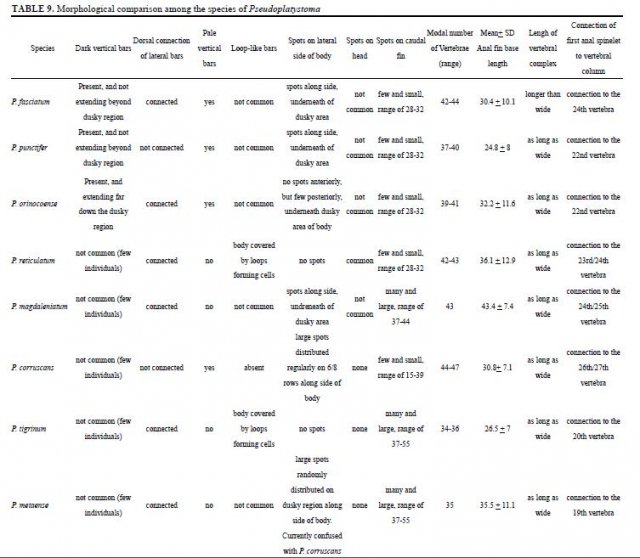Recently Jeff Rapps
B
bigguapote
brought into the country what he believes to be P. orinocoense, which appears to be the first time ever, if the ID holds when the fish hit adulthood.
Jeff has looked into the ID traits and is confident that the ID is correct per post #38 by Jeff himself about his orinocoense:
http://www.monsterfishkeepers.com/f...-think-could-it-be-p-corruscans.564171/page-4 (never mind the corruscans discussion, only orinocoense is relevant here)
 Comanswoodwork
Comanswoodwork
bought two of Jeff's fish and we have been following his thread with great interest:
http://www.monsterfishkeepers.com/forums/threads/pseudoplatystoma-orinocoense-pics-rare-tsn.658257/
The fish has drawn interest from others:
http://www.monsterfishkeepers.com/f...doplatystoma-orinocoense.670039/#post-7526055
So I thought I'd paste the info pertaining to orinocoense from the revision:
http://www.mapress.com/zootaxa/2007f/zt01512p038.pdf
************************** Orinocense ********************************


Diagnosis: A species of Pseudoplatystoma distinguished by a combination of the following features: well defined straight vertical bars along side of body, longer than those of P. fasciatum and P. punctifer; bars connecting to, or extending to, the dorsal region and continuing onto other side of body; vertical bars of anterior region straight and extending below dorsolateral dusky area; usually no spots below lateral line, some individuals with two or three spots; 39–41 vertebrae.
Description: Maximum recorded length 489.7 mm TL. Body moderately stout, profile of head an acute triangle or pointed toward lips, almost flat anteriorly. Head margins somewhat parallel when viewed dorsally. Mouth rounded with mesethmoid, premaxilla, and lower jaw covered interiorly by thick skin. Viewed dorsally, body widest measurement at pectoral fins, and tapers gradually toward caudal peduncle. Dorsal margin from dorsal fin to adipose fin straight, dorsal margin posterior to adipose fin straight. Ventral margin from mouth to origin of anal fin straight. Posterior surface of head with thin skin leaving almost exposed grooves and roughness on the posterior region of cranium. Median fontanel short and covered by rough and thick skin. Anterior nostrils tubular and whitish, posterior ones with a whitish triangular flap.
Eyes in dorsolateral position, ovoid and located at middle length of head. Maxillary barbels long, reaching origin of pelvic fins, their color blackish dorsally and yellowish ventrally. Chin barbels short in adults, not reaching beyond pectoral fin origin, longer in juveniles (<250 mm), extending beyond tip of pectoral spine. Opercle with pale flap on its margin.
Head and rest of body dark dorsal and laterally. Dark pigmentation reaching lateral line. Some individuals pale others yellow ventrally. Vertical bars distributed along side of body. Number of bars greater than in congeners from Guyana (P. fasciatum) (about 10 bars) and Amazon (P. punctifer) (about 11 bars) and varying between 10 to 14 with an average of 12. Last bar on caudal fin often boomerang–like. Generally, dark bars accompanied by whitish bars. Few individuals with one or two dark loops on posterior region of head. Dorsal fin with few spots on spine and rays. Adipose fin with few spots decreasing in size toward the margin. Pectoral and pelvic fins dark dorsally, pale ventrally. A comparison with other species is presented in Table 9. Color and pattern of adults are shown in Fig. 20.
Etymology: The specific epithet orinocoense refers to the Orinoco River, Venezuela, the drainage in which this species is endemic.
*********************************************************************************************
Key to the species of Pseudoplatystoma (IMHO of little use to us, laymen so I'll repaste the Table from post #3 for convenience and the Key will follow)

1. (a) More than 50 spots in the caudal fin, anterior projection on the lateral ethmoid (Fig. 8), ventral flange on the anterior process of the interopercle, tooth patch of infrapharyngobranchial # 5 covers only the dorsal region of that bone, width of the lateral ethmoid at the joint with infraorbital 1+2 (io 1+2) very narrow (as much as 3/4 narrower than the width of the lateral ethmoid in P. fasciatum, P. punctifer, P. orinocoense, P. reticulatum, P. corruscans and P. magdaleniatum . . . . . . . . . . . . . . . . . . . . . . . . . . . . . . 2
(b) Fewer than 45 spots in the caudal fin, no anterior projection on the lateral ethmoid, absence of ventral flange on the anterior process of the interopercle, tooth patch of infrapharyngobranchial # 5 covers dorsal and extends over 2/3 of ventral region of that bone, wide lateral ethmoid at the joint with infraorbital 1+2 (io1+2). . . . . . . . . . . . . . . . . . . . . . . . . . . . . . . . . . . . . . . . . . . . . . . . . . . . . . . . . . . . . . . . . . . . . . . . . . . . 3
2. (a) Dark loops or reticulated bars along the side of the body (Fig. 15), no spots on the lateral region of the body . . . . . . . . . . . . . . . . . . . . . . . . . . . . . . . . . . . . . . . . . . . . .P. tigrinum (Amazon River and tributaries).
(b) Dark vertical bars and few spots (no more than 10) randomly distributed along the side of the body. . . . . . . . . . . . . . . . . . . . . P. metaense, n. sp. (Orinoco River and tributaries in Colombia and Venezuela).
3. (a) Nuchal plate # 1 expanded, posterior region of the metapterygoid wider than in the other species . . . . . . . . . . . . . . P. magdaleniatum, n. sp. (Magdalena and Cauca rivers, north–central region of Colombia).
(b) Nuchal plate # 1 reduced and not expanded . . . . . . . . . . . . . . . . . . . . . . . . . . . . . . . . . . . . . . . . . . . . . 4
4. (a) Thick loop–like or reticulated bars on the side of the body, dark loop–like bars join those in the dorsal region of the body forming distinct cells, dorsal region of head has either loops or spots . . . . . . . . . . . . . . . . . . . . . . . . . . . . . . . . . . . . . . . . . . . . . . . . . . . . . . . . . . . . . . P. reticulatum (Amazon and Paraná rivers)
(b) No loop–like bars on the side of the body; spots or pale vertical bars common and located close to the dark vertical bars . . . . . . . . . . . . . . . . . . . . . . . . . . . . . . . . . . . . . . . . . . . . . . . . . . . . . . . . . . . . . . . . . . . . 5
5. (a) Spots distributed regularly in six to eight rows from the posterior margin of the opercle to the tail . . . .P. corruscans (Paraná and São Francisco rivers, in Argentina, Paraguay, Uruguay and southeast Brazil).
(b) Straight dark vertical bars along the side of the body . . . . . . . . . . . . . . . . . . . . . . . . . . . . . . . . . . . . . 6
6. (a)Well–defined straight dark vertical bars on the side of the body, longer than those in P. fasciatum and P. punctifer, vertical bars of the anterior region also straight and extending below the dorsolateral dusky area, bars do not form spots as seen on other species, usually no spots below lateral line, some individuals have two or three spots . . . . . . . . . . . . . . . . . . . . . . . . . . . . . . . . . . . . . . . . . . . . . . . . . . . . . . . . . . . . . . . . . . . . . . . . . . . . . . . P. orinocoense, n. sp. (Orinoco River, and its tributaries in Colombia and Venezuela).
(b) Dark vertical bars form spots below the lateral line, well–defined pale vertical bars, distinct demarcated boundary between the dusky dorsolateral and pale ventrolateral regions of the body . . . . . . . . . . . . . . . 7
7. (a) First spinelet of the anal fin contacts the haemal arch of the 24th vertebra, some specimens have spots below the laterodorsal dark region, 43–45 vertebrae. . . . . . . . . . . . . . . . . . . . . . . . . . . . . . . . . . . . . . . . . . . . . . . . . . . . . . . . . . . . . . . . . . . . . . . . . . . . . . . .P. fasciatum (Rupununi, Essequibo and Suriname rivers).
(b) First spinelet of the anal fin contacts the haemal arch of the 22 nd vertebra, 37–40 vertebrae, free discrete dark spots below the laterodorsal dark region (Fig. 15), adipose fin with fewer (6 or 8) spots than on P. fasciatum . . . . . . . . . . . . . . . . . . . . . . . . . . . . . . . . . . . . . . P. punctifer (Amazon River and tributaries)








![P211213_00.18_[01].jpg P211213_00.18_[01].jpg](https://www.monsterfishkeepers.com/forums/data/attachments/776/776462-d4693229b80249797b1865240c8660ba.jpg?hash=1GkyKbgCSX)






